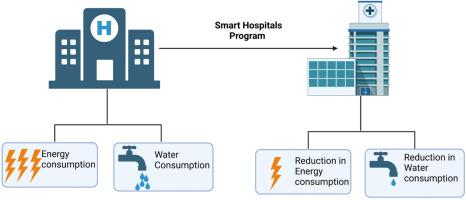保健设施的智能绿化举措:加勒比关于环境可持续性和抗灾能力的案例研究
IF 3.6
引用次数: 0
摘要
背景:在七个加勒比国家实施了智能医院方案,以增强中小型医疗机构的抗灾能力和环境可持续性。该倡议的重点是提高能源效率、节约用水和整体环境绩效,同时确保在灾害易发地区不间断地提供医疗保健服务。方法使用绿色检查表进行设施评估,绿色检查表是根据LEED标准为加勒比卫生保健设施量身定制的工具。改造前后的评价以节约用水和能源、空气质量和废物管理为目标。干预措施包括基础设施升级,如光伏系统、节能设备和雨水收集系统,以及对员工进行资源保护培训。结果Vieux Fort医疗机构的能源消耗下降了47.7%,平均每月减少-5773千瓦时(95% CI:6175至-5371;p < 0.0001; t = 31.61, df = 11)。Comfort Bay的平均降幅为26.6% (-1919 kWh; p = 0.0005; W = -78.00)。其中,Saltibus的用水量减少58.5%(每月减少40456加仑;p = 0.0005; W = -78.00), Vieux Fort的用水量减少18.1%(每月减少6924加仑;p = 0.0005; W = -78.00), Mongouge的用水量减少7.2%(每月减少1269加仑;p = 0.0005; W = -78.00)。这些减少突出了各设施在资源效率和运营可持续性方面的重大改进。智能医院项目显著降低了水和能源消耗,显示了有针对性的改造干预措施在提高医疗设施的可持续性和复原力方面的潜力。虽然结果突出了项目的有效性,但维护挑战和使用模式的可变性强调了持续监控和定制策略的必要性,以维持这些成果。该模型为资源受限和灾害多发地区的类似举措提供了有价值的见解。本文章由计算机程序翻译,如有差异,请以英文原文为准。

Smart greening initiatives for healthcare facilities: A caribbean case study on environmental sustainability and disaster resilience
Background
The Smart Hospitals Program was implemented in seven Caribbean countries to enhance disaster resilience and environmental sustainability in small- to medium-sized healthcare facilities. The initiative focused on improving energy efficiency, water conservation, and overall environmental performance while ensuring uninterrupted healthcare service delivery in disaster-prone regions.
Methods
Facility assessments were conducted using the Green Checklist, a tool tailored for Caribbean healthcare facilities based on LEED standards. Pre- and post-retrofit evaluations targeted water and energy conservation, air quality, and waste management. Interventions included infrastructure upgrades—such as photovoltaic systems, energy-efficient equipment, and rainwater harvesting systems—and staff training on resource conservation.
Results
Energy consumption at the Vieux Fort Healthcare Facility decreased by 47.7 %, with a mean monthly reduction of -5773 kWh (95 % CI:6175 to -5371; p < 0.0001; t = 31.61, df = 11). Comfort Bay showed a median reduction of 26.6 % (-1919 kWh; p = 0.0005; W = -78.00). Water consumption reductions included 58.5 % at Saltibus (-40,456 gallons per month; p = 0.0005; W = -78.00), 18.1 % at Vieux Fort (-6924 gallons per month; p = 0.0005; W = -78.00), and 7.2 % at Mongouge (-1269 gallons per month; p = 0.0005; W = -78.00). These reductions highlight significant improvements in resource efficiency and operational sustainability across facilities.
Conclusions
The Smart Hospitals Program achieved significant reductions in water and energy consumption, demonstrating the potential of targeted retrofitting interventions to enhance sustainability and resilience in healthcare facilities. While the results highlight the program's effectiveness, maintenance challenges and variability in usage patterns underscore the need for ongoing monitoring and tailored strategies to sustain these gains. This model provides valuable insights for similar initiatives in resource-constrained and disaster-prone regions.
求助全文
通过发布文献求助,成功后即可免费获取论文全文。
去求助
来源期刊

The journal of climate change and health
Global and Planetary Change, Public Health and Health Policy
CiteScore
4.80
自引率
0.00%
发文量
0
审稿时长
68 days
 求助内容:
求助内容: 应助结果提醒方式:
应助结果提醒方式:


